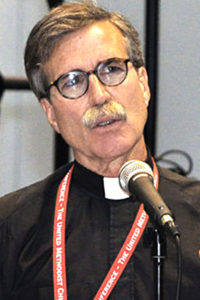HE WAS BORN IN A BETHLEHEM BARN FOR THE FORGIVENESS OF SINS
“For us and for our salvation he came down from heaven, was incarnate of the Holy Spirit and the Virgin Mary and became truly human….
“We acknowledge one baptism for the forgiveness of sins….”
–The Nicene Creed
(In 2025, the 1,700th anniversary of the First Council of Nicaea will be celebrated throughout the Church catholic.)
______________________________________________________________________________________
According to The Nicene Creed, Jesus Christ was born in a Bethlehem barn so that, in time, He would die on a cross so that our sins could be forgiven and we could be saved. Truly, the Gospel is the Gospel of forgiveness — the Gospel of the forgiveness of sins. No wonder the Gospel means the Good News! Indeed, the Gospel is Good News to all the world, to the Church, and to each of us.
From the time of the Apostolic Church, abortion has been and is considered one of the many sins named by the Church. The Didache, a Christian document written at the end of the First Century, explicitly condemns abortion. Early on, the Church believed that intentionally taking the life of an unborn child was and is a sin. Abortion is a forgivable sin, but a sin nevertheless.
According to the early Church, a woman who seeks out, and/or succumbs to an abortion has sinned; the Good News is that she can repent, be baptized (or be renewed in her baptism), and receive the forgiveness of sins. This was made possible by Jesus Christ. He was born a baby boy in a Bethlehem barn (and not aborted) so that He could grow up and die on an old, rugged cross for the forgiveness of sins, for the salvation of the world.
SINS AROUND ABORTION
When considering abortion, Christians too often see sin only in the woman who consents to abortion. That is sin, to be sure. Most churches today — Catholic, Protestant, and Orthodox — have teaching to that effect. (Only mainline or oldline Protestant churches often have gone “wobbly” and framed abortion as a “tragic necessity” or as a “reproductive right” or as “reproductive healthcare.”) In an abortion, the sin of the little one’s mother is the most obvious sin involved.
But there are many other sins that surround an act of abortion. Consider some of them.
There are the sins of the abortionist and those who assist the abortionist. Falsely promising a quick fix to a desperate woman, abortion’s practitioners extort exorbitant fees from their victims.
There is the sin of the boyfriend or husband. Lacking love and loyalty and courage, he encourages his girlfriend or wife to obtain an abortion.
There is the sin of the aborting woman’s parents, who pressure their daughter, perhaps a college student with a bright future, to “take care of it.”
Perhaps the same parents taught their daughter no moral self-restraint. They taught her to think of herself as a princess. Seldom taking her to church, synagogue, or mosque, they allowed Mickey Mouse and Disney, and then MTV, to raise her.
There is the sin of the pregnant woman’s other friends. They failed to engage in difficult conversations with their girlfriend. They could have, but did not, challenge their friend to trust God, to obey God, to practice hope, to slow down, to persevere, to protect her child — all with God’s help.
There is the sin of teachers at school. Through what they said and what they did not say, they conveyed the ideas that intimate relations among young people are “not a big deal,” that “everyone” engages in them, that “problems” can always be taken care of.
There is the sin of pastors at the area churches. In their preaching, teaching, and writing, they avoided topics like pre-marital intimacy and abortion, assuming that, if they brought them up and taught the Church’s apostolic faith, they would face sudden removal and perhaps excommunication from their churches!
There is the sin of politicians — in town, city, county, state, and federal governments. Afraid of being defeated in the next election, they vote for “choice” against protecting the unborn, and generally try to avoid discussing in public abortion-related matters.
There is the sin of the creators and sellers of popular culture. Their work confuses the two genders. It degrades intimacy. Elevates self-expression above all. Scorns marriage. Despises children. Laughs at sacrifice. Legitimates using others. Promotes violence. Dismantles tradition. Eliminates truth. Reduces morality to feelings. Taken together, these facts of cultural life make abortion thinkable, necessary, and doable.
You get the idea. When a single abortion occurs, there are many other sins that have made it possible to end the life of an innocent, unborn child. So there are many people, many sinners, who helped make the abortion imaginable and doable.
HE, NOT SIN, HAS THE LAST WORD
The sins of the world, some leading to abortion, are why Jesus Christ was born in a Bethlehem barn. One who was born lived and died for the sins of those who did not allow children to be born. Sent by God the Father, God the Son came to save, to deliver, to release, to forgive those knotted up by sins and resulting guilt, and to bring new life!
“Good Christian friends, rejoice with heart and soul and voice; now ye need not fear the grave: News, news! Jesus Christ was born to save! Calls you one and calls you all to gain his everlasting hall. Christ was born to save, Christ was born to save!” (“Good Christian Friends, Rejoice,” verse 3)










